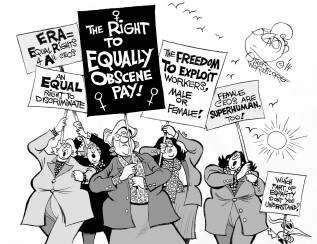I would like to analyze the contribution of gender towards the global trends of inequality. Let’s talk about gender, income and wealth.
Let me make it very clear since the beginning that women continue to be discriminated against in different parts of the world.
Before starting, one of the questions that we need to ask ourselves is that, is their any change on the horizon about the way women are treated and if yes, then how does it affect the economy, politics and the society as a whole.
1. PATRIARCHY
According to the World Bank’s report of 2010, in 45 out of 128 countries women don’t have the same legal capacity to act or engage in economic transactions.
In 49 out of these 128 countries women can’t work in all industries.
And in 32 of 128 countries, women don’t have equal inheritance rights.
Thus patriarchy gravely limits the role that women have traditionally played and continue to play in the global scenario.
2. GENDER INEQUALITY IN WAGES
This occurs due to job segregation and the large differences that persist within the occupational groups and positions even when women have similar education and experience.
The ‘mommy penalty’ is another issue which causes part time work and career progression interruption.
It is also seen that poverty is commonplace in female headed households.
3. GENDER INEQUALITY IN WEALTH
Historically it is driven by low female labor force participation rates, gender discrimination in pay, patrilineal inheritance rules, etc.
However the gap is narrowing nowadays in terms of wealth. This can be attributed to:
- Greater female labor force participation rates
- Longer life expectancy for females, given that most wealth is owned by people over 50 years of age.
Another interesting aspect is that of high net worth individuals. The HNWIs are those people who own over $1 million of investable assets excluding primary residence, collectibles, consumables and consumer durables.
In 2008, HNWIs percentage among females in the world was 24% which rose to 27% in 2010. These figures were as follows for other regions:
| REGION | % of HNWIs (females) |
| North America | 37 |
| Japan | 31 |
| Asia pacific (including India and China) | 24 |
More than half of the HNWIs in the US, India, China and Japan will be women in the next 15- 20 years. This will also imply an end to patriarchy.
But how will more women in the global scenario affect the economy and the society?
- Women are more prone to ensure that their retirement assets last throughout their lifetime.
- They are more concerned about the future of social security benefits.
- They worry a lot more about the rising cost of children’s education
- And also are more careful about the prospect of what caring for an aging parent could do to their own financial security.
Thus we can conclude that women remain more conservative and have less risk taking capacity. This will impact the world in a big way.
We can see that the world is changing and will change more so in the future. Women will play a considerably important role in the global economics, polity and society.
Be ready to be ruled by the females!


































